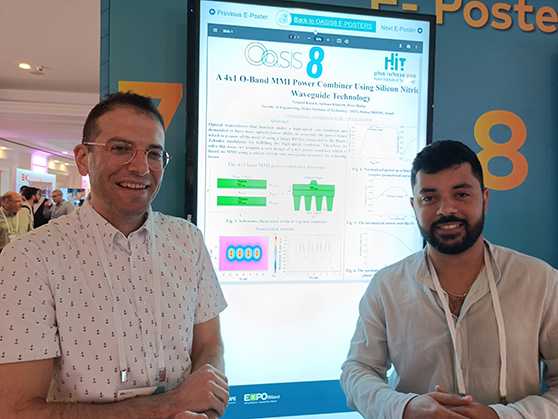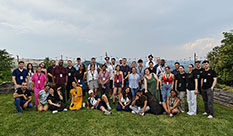More:
News & Stories
Undergraduate students in prestigious scientific magazines
Nathaniel Ketch and Salman Khatib, students the Faculty of Electrical and Electronics Engineering, scored an impressive achievement while still in their undergraduate studies with the publication of two important articles in international prestigious journals.

from left to right: Dr. Dror Malka and Nathaniel Ketch
Publishing academic articles for students during their studies is an extraordinary achievement. But it seems that, as in many fields, HIT Holon Institute of Technology is one of a kind when 2 of its graduates, Nathaniel Ketch and Salman Khatib, published 2 academic articles that made their way to leading scientific journals, Applied Sciences and Micromachines and even presented their research work at the Oasis 8 conference - the leading exhibition for the field of optics and electro-optics in Israel.
The articles of both students deal with photonic transmitters operating at a high data transfer rate (over 150 Gb/s) in the O-Band spectrum (1260-1360nm) which require at least 100 milliwatts of power to overcome the power losses caused by the use of high speed :
Photonic transmitters that operate with high data transfer rate (over 150 Gb/s) at the O-band range (1260-1360 nm) require at least 100 milliwatts of power for resolving the power losses that is cased from using high-speed modulators. A high-power laser can probably handle this requirement, however for transmitter system this solution can be problematic due to the nonlinear effects that can happen which may lead to high noise in the transmitter system.
Thus, to solve this issue, we propose a new design of 2x1 multimode interference (MMI) coupler power combiner using silicon nitride (SiN) slot waveguide structures. The MMI power combiner and the SiN slot waveguide structures were optimized using the full-vectorial beam propagation method (FV-BPM) and the finite difference time domain (FDTD) method. After combining two sources, high efficiency was obtained of 94.8-97.6% from the total power after a short coupling length of 109.81 µm over the O-band range with a low back reflection of 44.94 dB. Thus, the proposed device can be very useful for combining two O-band sources for gaining a higher power level which can be utilized to improve performances in transmitter systems.
Transceivers that function under a high-speed rate (over 200 Gb/s) are demanded to have more optical power ability to overcome the power losses which is a cause of using a larger RF line connected to the Mach-Zehnder modulator for obtaining high data bitrate communication. One option to solve this problem is to use a complex laser with a power of over 100 milliwatts. However, this option can be complicated for a photonic chip circuit due to the high cost and nonlinear effects, which can increase the system noise. Therefore, we propose a better solution to increase the power level using a 4x1 power combiner which is based on multimode interference (MMI) using a silicon nitride (Si3N4) slot waveguide structure.
The combiner was solved using the full-vectorial beam propagation method (FV-BPM) and the key parameters were analyzed using Matlab script codes. Results show that the combiner can function well over the O-band spectrum with high combiner efficiency of at least 98.2% and after a short light coupling propagation of 28.78 μm. This new study shows how it possible to obtained a transverse electric mode solution for four Gaussian coherent sources using Si3N4 slot waveguides technology.
Furthermore, the back reflection (BR) was solved using a finite difference time domain method and the result shows a low BR of 40.15 dB. This new technology can be utilized for combining multiple coherent sources that work with a photonic chip at the O-band range.
Dr. Dror Malka, a lecturer in the Faculty of Electrical and electronics Engineering, explains that this is a groundbreaking achievement: "Usually undergraduate students do not publish articles and here we are dealing with a brilliant duo offering a great solution that can already be applies by the optical communications industry in Israel," said Dr. Malka and noted that a search shows that the article has already begun to be cited throughout the academic world and, in addition, HIT’s faculty of Electric ad Electronics Engineering has already started to receive inquiries about the article from the some if the major companies in the field.
"Thanks to a year of hard work and a lot of encouragement from our lecturer, Dror, we got to where we are. We didn't think we would get this far, and if way back, you had told me that the article would make it to the biggest conference in Israel for optical communication, I wouldn't have believed it," says Nathaniel Ketch, one of the writers.
- News & Events
International Week of Interdisciplinary Studies and Academic Collaborations in Crete
A substantial delegation of 16 students and four faculty members from HIT Holon Institute of Technology participated in week-long international activities and events at HMU-Hellenic Mediterranean University in Crete. ...


 Additional programs
Additional programs
